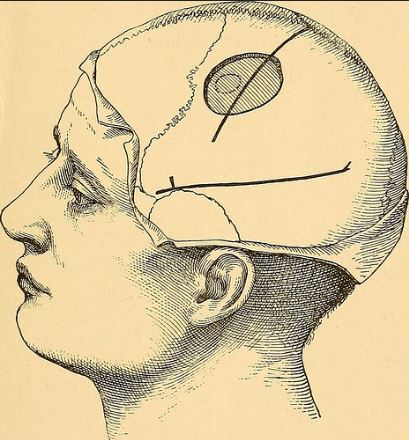The Lesser (King’s) Evil

Brain Surgery, 1893
A busy day, so I present one of those gruesome WTH stories, you’ve grown to know and love:
[From The Cumberland (Pa.) News.]
DOMESTIC SURGERY.
We have just come into possession of the facts of a remarkable circumstance which occurred in this vicinity some time since. A middle-aged lady who resides near Wellers, Pa., a few miles from this city, whose name is omitted by the request of friends, was afflicted by that terrible disease, scrofula, the seat of the disorder being in her head. She suffered terrible agony from the pressure of the diseased cranium upon the brain, and her physician decided that the only means of relief was the removal of the top of her skull. He never attempted the operation, however, fearing she might die from its effects. The woman continued to suffer, and her son, who was afflicted with the same disease, determined to take the risk and perform the operation. He was considerable of a mechanical genius [sic], and he soon constructed a fine saw for the purpose, the material used being wire from an old hoop-skirt. After he had finished the instrument, although he had no surgical knowledge, he began the operation of sawing through the skull at a point about two inches below the summit of the cranium.
After working some time at the operation the young man was taken ill and died. After his death the lady’s daughter, a young lady of nineteen or twenty, decided to continue the work, and did so, succeeding in removing the top of her mother’s head, relieving the terrible pain, and probably saving her life. She was occupied several days in the operation, which was a delicate and dangerous one ordinarily, to be performed by the most skillful surgeon. If the improvised instrument had been driven too deep and penetrated the delicate covering of the brain, instant death would have resulted, and that some accident of the sort did not occur is one of the most astonishing facts about the matter. She undertook the operation as a desperate resort, and the exercise of nerve which sustained her was wonderful. Once while working she fainted, and frequently would throw down the saw, declaring she would go no further. Her mother, whose enormous will power was not less wonderful, always urged her to proceed, saying: ”If I can stand it, you should do the same, as it is the only way of saving my life.” No anaesthetic was used, and the afflicted woman earnestly watched and directed the operation.
As stated, instantaneous relief followed the removal of the diseased bone, although the disease was not eradicated. The removed bone was replaced by a silken cap, carefully fitted. The operation was performed over six months ago, and the lady was at last accounts alive and cheerful, though of course, confined to a limited sphere of action. She took a very philosophical view of the affair, and seems grateful that relief was afforded, although she will remain an invalid for life. The case is certainly a remarkable one, and if the facts were met with in a work of fiction, the story would probably be regarded as a clever but far-fetched fabrication “out of the whole cloth.” But the case is well authenticated, and we have stated the facts without addition or change as we obtained them from a reliable source.
Brotherhood of Locomotive Engineer’s Monthly Journal 1879
Ah, the old “reliable source,” familiar to us all! But no names given…
Scrofula was a tubercular infection of the lymph glands of the neck, known as “The King’s Evil,” and “touched” for by the British and French sovereigns, in a divine rite of healing. I thought it only manifested in the soft tissues, but there is also osseous tuberculosis. (Or am I mistaken and scrofula can spread to the skull? chriswoodyard8 AT gmail.com.) The term “scrofulous” also seems to have been used very loosely in discussions of eugenics for a diseased and “unfit” person.
This dire story is reminiscent of the people who perform DIY trephination at home, believing it to produce Enlightenment, or relieve headache, depression, or chronic fatigue. The idea of a saw (which must have been like a jeweler’s saw or small band-saw—hoop-skirt metal “wires” were usually made of steel and were either like heavy-gauge fence wire or flat strips an inch or two wide— cutting into an un-anaesthetized head is beyond horrifying. If this is not an urban legend, it is a testament to the desperation of the suffering lady who felt that this prolonged operation was the lesser of two evils, and who trusted to the steady touch of her daughter’s hand. One wonders if her son also had the disease, and died of it, and how long the lady survived in her carefully fitted silk cap.
Chris Woodyard is the author of The Victorian Book of the Dead, The Ghost Wore Black, The Headless Horror, The Face in the Window, and the 7-volume Haunted Ohio series. She is also the chronicler of the adventures of that amiable murderess Mrs Daffodil in A Spot of Bother: Four Macabre Tales. The books are available in paperback and for Kindle. Indexes and fact sheets for all of these books may be found by searching hauntedohiobooks.com. Join her on FB at Haunted Ohio by Chris Woodyard or The Victorian Book of the Dead. And visit her newest blog, The Victorian Book of the Dead.
